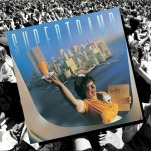Tamra Davis
Jean-Michel Basquiat: The Radiant Child director Tamra Davis has a reputation for cultivating great performances from her high-profile actors, most of whom she got to work with before they got famous: She directed Adam Sandler in Billy Madison, Chris Rock in CB4, and Dave Chappelle in Half Baked. (She also directed Britney Spears in Crossroads, back when Spears’ rep was still more positive than not.) Davis cut her teeth making music videos for N.W.A., Depeche Mode, Sonic Youth, and the Beastie Boys; she’s married to Beastie Mike D. While still in film school in California, Davis struck up a friendship with provocative painter and art-world superstar Jean-Michel Basquiat. She filmed a series of intimate interviews with him, but shelved them when he died. A few years ago, she unearthed them again at the insistence of friends, and started working on the newly released Radiant Child. The A.V. Club recently caught up with Davis to talk about the film, her relationship with Basquiat, Adam Sandler’s love of hurting children, and the difficulties of hiring Crips for music videos.
The A.V. Club: How did you approach turning your 20-minute interview with Basquiat into a feature-length documentary?
Tamra Davis: David Koh saw the short at Sundance, and he’s like, “Could you make this into a feature?” I was kind of like, “You know, I really like the purity of just Jean-Michel talking and painting.” It was hard for me to grasp the idea that I would start to introduce all those voices again that I felt [Basquiat] was commenting about. The more I thought about it, though, I realized that there were so many people that weren’t around in the ’80s that didn’t really know what I was battling against personally—all those opinions—and it would actually be very helpful for me to show people where he came from, and set up New York at that time. The more people I talked to—I kind of made this list of people I felt Jean-Michel would have wanted me to speak with. So I was very specific about “these are the people I think he would really want me to talk to.” Each of those people were so enlightening to me. Every time I walked out of an interview, I would just be like, “This person just said the most amazing things.” There was a real passion for me talking to each of those people that I hope translated in the film.
AVC: Were those people you knew from that time?
TD: Some of them, which I was grateful for, because that gave me access to them, or they had heard of me. A lot of times, they were people I’d only heard of, like Nick Taylor. I’d only seen his name on his photographs, so to go to his East Village apartment where he still lives after all these years and sit at a table and talk to him—it was like talking to an old friend. There’s an intimacy that comes from those moments that I feel is just so cool. The same thing happened with [Basquiat’s longtime girlfriend] Suzanne [Mallouk]. I felt like we were talking about an old friend at tea instead of just doing an interview.
AVC: How did reliving these memories of your friendship affect you emotionally?
TD: It was interesting, because it took about a year to edit the piece. I think what was hard about it was that I really wanted to make a film that moved you narratively. I wanted to make a film that wasn’t just a biography. When you watched it, you actually felt that you watched a movie, that you had an emotional reaction. In order to do that, I felt that I had to really keep myself emotionally raw while working on the film. I had to feel myself crying, so the audience could be moved, too. I think that part was quite hard, because I lived in this weird world for almost a year, trying to keep myself open to emotion for him. It was interesting, but also hard to go to the editing room and cry every day. Even trying to watch the film now from beginning to end without crying is so hard, but I think that emotion comes through in the film, which is the most important part.
AVC: You lived in Los Angeles back then, but did you ever experience what was going on in the scene in New York?
TD: My connection with Basquiat was really in Los Angeles, which really was a whole different world to what he was experiencing in New York. There were times that I did come back here and would hang out with him in New York and go to some of those clubs. By that time, it was already ’85 or ’86, so the scene was already kind of really picking up. When Glenn O’Brien started to describe New York in the early ’80s, I was like “Oh my God, what an amazing scene.” Thurston Moore had put on a no-wave photography show, and Jean-Michel was there. He was right in that scene. It was really important for me to talk to Thurston—who was also around the music scene at that time—to bring those aspects into the film. In order to understand Jean-Michel, you have to understand where he came from, and other artists he was around.





















![Rob Reiner's son booked for murder amid homicide investigation [Updated]](https://img.pastemagazine.com/wp-content/avuploads/2025/12/15131025/MixCollage-15-Dec-2025-01-10-PM-9121.jpg)


















